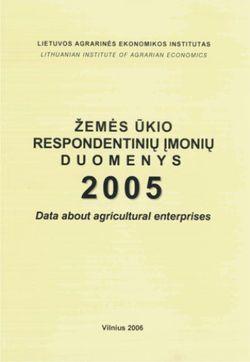
Statistical publications „Data about agricultural enterprises“ are published annually since 1996. The publication of 2006 is based on accountancy data of 2005 from 1286 family farms and 39 agricultural companies. Selected farms cover almost all districts, natural zones and reflect different farming conditions.
Lithuania must deliver data of 1000 farms to the EU Farm Accountancy Data Network (FADN). Lithuania is considered to be one FADN region, the threshold of the field of observation is 2 ESU (European Size Units). A sample farm represents approximately 30 farms. According to the Lithuanian legislation Lithuanian Institute of Agrarian Economics is assigned to be a Liaison Agency, Lithuanian Agricultural Advisory Service - Accountancy office.
In 2005 Farm Structure Survey (FSS) was carried out in Lithuania. Farm typology was calculated using standard gross margin (SGM) 2002 (Table 3). There are 30775 family farms and 469 agricultural companies above threshold (Tables 4 and 5). Structure of the sample farms is revealed in the tables 6 and 7 respectively. Data of FSS 2005 served to calculate weighted averages for both types of farms and cover almost completely field of observation.
Like in previous years, statistical results of family farms and agricultural companies are presented separately, as they are very different from both economic size and labour input. Some types of farming and economic size classes are aggregated. Averages of the previous year are also presented, what enables to compare farming results in the course of the last two years. In general, in 2005 they are better for both family farms and agricultural companies. Higher total output, notable larger subsidies allowed to increased farm income by 37 per cent in the family farms and almost twice in agricultural companies. Each year average economic size of a family farm grows. In 2005 utilized agricultural area increased by 29 per cent, number of dairy cows - 38 per cent, pigs - 20 per cent. This publication contains 55 tables. Both family farms and agricultural companies are grouped by:
- economic size;
- type of farming;
- area;
- land quality point.
In addition family farms are grouped by:
- farmer’s age;
- counties;
- less favoured (LFA) and normal areas.
Since the EC has announced FADN data 2004 of all EU countries (except for Malta), this publication contains 2 additional tables with some variables in these countries.
Types of farming in family farms (row headings in the tables of family farms)
1. specialist cereals, oilseeds and protein crops;
2. general field cropping;
3. horticulture and permanent crops;
4. specialist dairying;
5. mixed cropping;
6. mixed livestock, mainly grazing livestock;
7. field crops-grazing livestock, combined;
8. field crops and granivores, combined.
In the group 6 the farms of mixed livestock, mainly grazing one prevail, however, a few farms of cattle-dairying, rearing and fattening (code 43) are also included. Group 8 comprises the farms of specialist granivores, mixed livestock, mainly granivores and field crops and granivores, combined (codes 50, 72, 82).
Types of farming in agricultural companies (row headings in the tables of agricultural companies)
1. specialist cereals, oilseeds and protein crops;
2. general field cropping;
3. horticulture and permanent crops;
4. field crops- livestock, combined.
Group 4 comprises the farms of mixed cropping, mixed livestock, mainly granivores and field crops-grazing livestock, combined (codes 60, 72, 81).
© Quoting requires reference to the source and website address.
